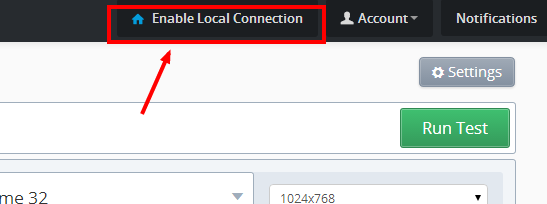This page relates to the legacy version of the tunnel that has been introduced to CrossBrowserTesting. If you use the new tunnel version, see Local Testing — Secure Tunnels.
We have a local connection option which allows you to test sites behind your firewall, or to access web pages that are saved locally on your machine. In just a few seconds, you can establish a connection which allows you to do live testing or screenshots against any of the internal sites you have access to.
To run a Local Connection, launch the dialog in the app:
You can find more information about the local connections here:
 Help article introducing our Chrome app for local connection
Help article introducing our Chrome app for local connection
 Using Node.js module on the command line
Using Node.js module on the command line
Internal Web site option
An encrypted tunnel is created between your machine and crossbrowsertesting.com. Our remote browsers are directed to send their traffic to your local proxy. All URLs are resolved locally via your proxy, so URLs with your internal DNS names will work just fine. The proxy will receive ALL traffic, such that if you test https://google.com, even this request will route through your tunnel and will be handled via your proxy server.
Requirements and limitations
Outbound SSH requests to port 443, SSL on crossbrowsertesting.com must be allowed via your firewall.
| Note: | Try to use your full IP address. |
Use http://yourinternalhostname.yourinternaldomain.com:80.
For localhost or 127.0.0.1 connection use the word local instead like this: http://local:80.
To test a web server inside your firewall, enter the same URL you would use from your local browser.
Local connections for real iPhone 8
http://local/ is currently blocked for real iPhone 8 devices. There are two workarounds to use local connections.
-
Set a hostname in your hosts file to route traffic to 127.0.0.1, and then access that URL.
For example, if your hosts file has the linetesting 127.0.0.1, then you can access localhost in a test via http://testing/. - Launch a test using your local IP address. For example, if you are hosting a server on your computer and your local IP address is 192.168.0.100, then you can access your server in a test via http://192.168.0.100/.
See Also
About Local Testing
How the Internal Web Site Local Connection Option Works
Testing Behind Your Firewall

